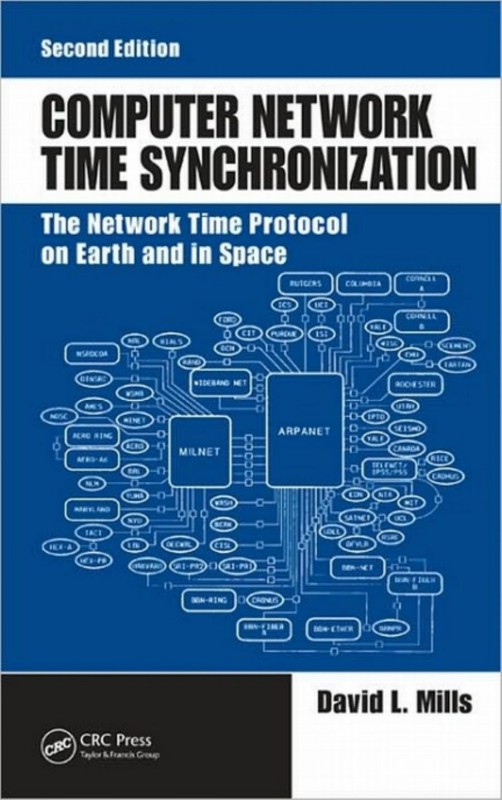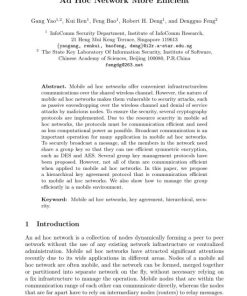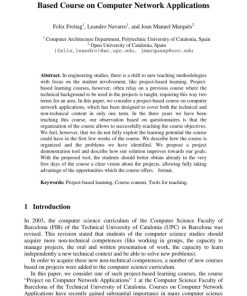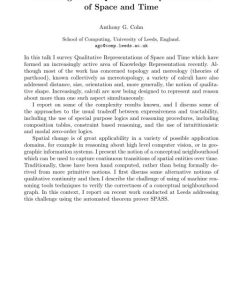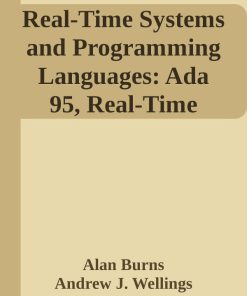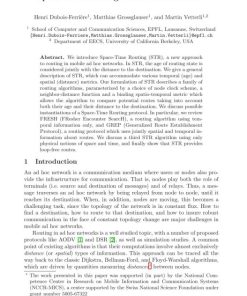Computer Network Time Synchronization The Network Time Protocol on Earth and in Space 2nd Edition by David L Mills ISBN 1351834045 9781351834049
$50.00 Original price was: $50.00.$25.00Current price is: $25.00.
Authors:David L. Mills , Tags:CRC Press , Author sort:Mills, David L. , Ids:9781439814635 , Languages:Languages:eng
Computer Network Time Synchronization The Network Time Protocol on Earth and in Space 2nd Edition by David L Mills – Ebook PDF Instant Download/Delivery. 1351834045, 9781351834049
Full download Computer Network Time Synchronization The Network Time Protocol on Earth and in Space 2nd Edition after payment
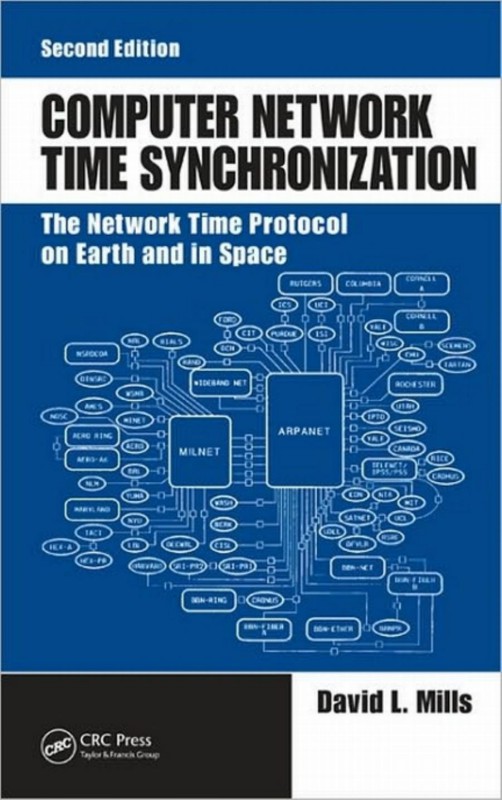
Product details:
ISBN 10: 1351834045
ISBN 13: 9781351834049
Author: David L Mills
Carefully coordinated, reliable, and accurate time synchronization is vital to a wide spectrum of fields—from air and ground traffic control, to buying and selling goods and services, to TV network programming. Ill-gotten time could even lead to the unimaginable and cause DNS caches to expire, leaving the entire Internet to implode on the root servers. Written by the original developer of the Network Time Protocol (NTP), Computer Network Time Synchronization: The Network Time Protocol on Earth and in Space, Second Edition addresses the technological infrastructure of time dissemination, distribution, and synchronization—specifically the architecture, protocols, and algorithms of the NTP. This system has been active in one form or another for almost three decades on the Internet and numerous private networks on the nether side of firewalls. Just about everything today that can be connected to a network wire has support for NTP. This book: Describes the principal components of an NTP client and how it works with redundant servers and diverse network paths Provides an in-depth description of cryptographic and other critical algorithms Presents an overview of the engineering principles guiding network configuration Evaluating historic events that have taken place since computer network timekeeping started almost three decades ago, the author details a number of systems and drivers for current radio, satellites, and telephone modem dissemination and explains how we reckon the time, according to the stars and atoms. The original 16 chapters of the first edition have been rewritten, updated, and enhanced with new material. Four new chapters cover new algorithms and previously uncovered concepts, including timekeeping in space missions. Praise for the first edition: “… For those that need an exhaustive tome on all of the minutiae related to NTP and synchronization, this is the source. … definitive … this book should be considered the last word on the topic.” —Ben Rothke on Slashdot.org “… the bible of the subject… contains enough information to take you just as far as you want to go….Dr. Mills is the original developer of NTP.” —Books On-Line
Computer Network Time Synchronization The Network Time Protocol on Earth and in Space 2nd Table of contents:
1 Basic Concepts
1.1 Time Synchronization
1.2 Time Synchronization Protocols
1.3 Computer Clocks
1.4 Processing Time Values
1.5 Correctness and Accuracy Expectations
1.6 Security
1.7 NTP in the Internet
1.8 Parting Shots
2 How NTP Works
2.1 General Infrastructure Requirements
2.2 How NTP Represents the Time
2.3 How NTP Reckons the Time
2.4 How NTP Disciplines the Time
2.5 How NTP Manages Associations
2.6 How NTP Discovers Servers
2.7 How NTP Deals with Stale Time Values
2.8 How NTP Manages Network Resources
2.9 How NTP Avoids Errors
2.10 How NTP Performance Is Determined
2.11 How NTP Controls Access
2.12 How NTP Watches for Terrorists
2.13 How NTP Clocks Are Watched
2.14 Parting Shots
3 In the Belly of the Beast
3.1 Related Technology
3.2 Terms and Notation
3.3 Process Flow
3.4 Peer Process
3.5 Poll Process
3.6 On-Wire Protocol
3.7 Clock Filter Algorithm
3.8 Select Algorithm
3.9 Cluster Algorithm
3.10 Combine Algorithm
3.11 Mitigation Rules and the Prefer Peer
3.11.1 The Prefer Peer
3.11.2 Peer Classification
3.11.3 Mitigation rules
3.11.4 The minsane Option
3.12 Huff-’n-Puff Filter
3.13 Orphan Mode
3.14 Rate Control and the Kiss-o’-Death Packet
3.14.1 Average Headway and Guard Time
3.14.2 The Kiss-o’-Death Packet
3.15 Parting Shots
4 Clock Discipline Algorithm
4.1 Feedback Control Systems
4.2 Phase and Frequency Discipline
4.3 Time and Frequency Response
4.4 Poll Interval Control
4.5 Popcorn and Step Control
4.6 Clock State Machine
4.7 Parting Shots
5 NTP System Engineering and Configuration
5.1 Core Engineering Principles
5.2 Engineering Large Corporate and Campus NTP Systems
5.3 Examples of Large Corporate NTP Systems
5.4 Engineering Home Office and Small Business NTP Systems
5.5 Network Considerations
5.6 General Configuration Considerations
5.7 Manual Server Discovery
5.8 Automatic Server Discovery
5.8.1 Broadcast/Multicast Discovery
5.8.2 NTP Manycast Discovery
5.8.3 NTP Pool Discovery
5.9 Configuration Commands and Options
5.9.1 Association Configuration Options (server, peer, and the Like)
5.9.2 Type of Service Options (tos)
5.9.3 Tinker Options (tinker)
5.10 Parting Shots
6 NTP Performance in the Internet
6.1 Performance Measurement Tools
6.2 System Clock Latency Characteristics
6.3 Characteristics of a Primary Server and Reference Clock
6.4 Characteristics between Primary Servers on the Internet
6.5 Characteristics of a Client and a Primary Server on a Fast Ethernet
6.6 Results from an Internet Survey
6.7 Server and Network Resource Requirements
6.8 Parting Shots
7 Primary Servers and Reference Clocks
7.1 Driver Structure and Interface
7.2 Serial Timecode Drivers
7.3 Generic Modem Driver
7.4 Local Clock Driver
7.5 PPS Interface and Driver
7.6 Audio Drivers
7.6.1 IRIG Driver
7.6.2 WWV/H Driver
7.6.3 CHU Driver
8 Kernel Timekeeping Support
8.1 System Clock Reading Algorithm
8.2 Kernel Discipline Algorithms
8.3 Kernel PLL/FLL Discipline
8.4 Kernel PPS Discipline
8.5 Clock Adjust Algorithm
8.6 Proof of Performance
8.7 Kernel PLL/FLL Discipline Performance
8.8 Kernel PPS Discipline
8.9 Parting Shots
9 Cryptographic Authentication
9.1 NTP Security Model
9.1.1 On the Provenance of Filestamps
9.1.2 On the Naming of Things
9.1.3 On Threats and Countermeasures
9.2 NTP Secure Groups
9.3 Autokey Security Protocol
9.3.1 Session Key Operations
9.3.2 X509 Certificates
9.3.3 Protocol Operations
9.4 Parting Shots
10 Identity Schemes
10.1 Identity Schemes
10.1.1 Private Certificate Identity Scheme
10.1.2 Trusted Certificate identity Scheme
10.1.3 Schnorr identity Scheme
10.1.4 guillou-Quisquater identity Scheme
10.1.5 Mu–Varadharajan Identity Scheme
10.2 Cryptotypes
10.3 Parting Shots
11 Analysis of Errors
11.1 Clock Reading Errors
11.2 Timestamp Errors
11.3 Sawtooth Errors
11.4 Peer Error Budget
11.5 System Error Budget
11.6 Parting Shots
12 Modeling and Analysis of Computer Clocks
12.1 Computer Clock Concepts
12.2 Mathematical Model of the Generic Feedback Loop
12.2.1 Type I FLL Feedback Control Loop
12.2.2 Type II Feedback Control Loop
12.3 Synthetic Timescales and Clock Wranglers
12.4 Parting Shots
13 Metrology and Chronometry of the NTP Timescale
13.1 Scientific Timescales Based on Astronomy and Atomic Physics
13.2 UTC and the Leap Second
13.3 The Leap Second Controversy
13.4 How NTP Reckons with UTC Leap Seconds
13.5 On Numbering the Calendars and Days
13.6 On the Julian Day Number System
13.7 On Timescales and the Age of Eras
13.8 On NTP Era and Timestamp Calculations
13.9 Comparison with Other Computer Timescales
13.10 Primary Frequency and Time Standards
13.11 Time and Frequency Coordination
13.12 Time and Frequency Dissemination
13.12.1 Shortwave Radio Services
13.12.2 long-Wave radio Services
13.12.3 Geosynchronous Operational Environmental Satellite Service
13.12.4 Telephone Modem Services
13.12.5 Global Positioning System
13.12.6 LORAN-C Radio Navigation System
13.13 Parting Shots
14 NTP Reference Implementation
14.1 NTP Packet Header
14.2 Control Flow
14.3 Main Program and Common Routines
14.4 Peer Process
14.5 System Process
14.6 Clock Discipline Process
14.7 Clock Adjust Process
14.8 Poll Process
14.9 Parting Shots
15 Precision System Clock Architecture
15.1 Limitations of the Art
15.2 Precision System Clock
15.2.1 Timer Oscillator
15.2.2 Timestamp Counter
15.2.3 real-Time Clock
15.2.4 Precision System Clock Implementation
15.2.5 Precision System Clock Operations
15.3 Principles of Precision Timestamping
15.3.1 Timestamp Transposition
15.3.2 Error Analysis
15.3.2.1 Reciprocity Errors
15.3.2.2 Transposition Errors
15.3.2.3 Interworking Errors
15.3.2.4 Store-and-Forward Errors
15.3.2.5 Nonreciprocal Rate Errors
15.4 IEEE 1588 Precision Time Protocol
15.4.1 Timestamp Capture
15.4.2 PTP Clock Architecture
15.4.3 PTP Messages
15.4.4 Best Master Clock Algorithm
15.4.5 Data Set Comparison Algorithm
15.4.6 PTP Time Transfer
15.4.7 PTP and NTP Compared
15.5 Have Quick, STANAG 4330, and Precise Time and Time Interval Have Quick Interfaces
15.6 Parting Shots
16 NTP Interleaved Modes
16.1 Basic/Interleaved Protocol State Machines and Flowcharts
16.2 Basic Symmetric Mode
16.3 Interleaved Symmetric Mode
16.4 Interleaved Broadcast Mode
16.5 Error Detection and Recovery
16.6 Measured Performance with the Interleaved Modes
16.7 Parting Shots
17 Time Transfer for Space Data Links
17.1 Orbit Mechanics
17.2 Clock Comparisons and the Effects of General Relativity
17.3 Time Transfer from a Planet to the Solar System Barycenter
17.4 Time Comparisons between Clocks in Space
17.5 Spacecraft Electronics
17.6 Proximity-1 Protocol
17.7 Proximity-1 Time Service
17.8 Time Transfer Using the Electra Transceiver
17.9 Parting Shots
18 Time Transfer for Deep-Space Missions
18.1 Time Transfer between Earth Stations
18.2 Time Transfer to Earth Satellites
18.3 Time Transfer to the Moon and Satellites of Other Planets
18.4 Time Transfer for a Planetary Space Fleet
18.5 Time Transfer for Deep-Space Missions
18.6 Parting Shots
19 Technical History of NTP
19.1 On the Antiquity of NTP
19.2 On the Proliferation of NTP around the Globe
19.3 Autonomous Authentication
19.4 Autonomous Configuration
19.5 Radios, We Have Radios
19.6 Hunting the Nanoseconds
19.7 Experimental Studies
19.8 Theory and Algorithms
19.9 Growing Pains
19.10 As Time Goes By
19.11 Parting Shots
People also search for Computer Network Time Synchronization The Network Time Protocol on Earth and in Space 2nd:
computer network time synchronization
computer network time synchronization pdf
computer network time synchronization the network time protocol
computer network time synchronization the network time protocol pdf
network time synchronization windows 10

